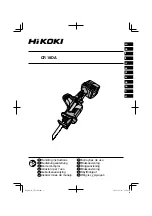
General Safety Precautions
1.
Be sure the blade rotates clockwise when facing the saw from the left side. Blade must rotate to the front of the saw.
2.
Be sure all clamp handles are tight before turning motor on.
3.
Keep the blade sharp and properly set.
4.
Hold material firmly against the guide strip when cutting.
5.
Be sure the blade and arbor collars are clean and the recessed side of the collars are against blade.
6.
Never oil or grease arm trackways or motor.
7.
Do not start machine without proper tool guard.
8.
Do not remove the anti-kickback device from the blade guard. Adjust it to just clear the work.
9.
Keep motor air slots clean.
10. Return roller head to full rear after each operation.
General Cautions When Using the Lower Blade Guard:
1.
The lower blade guard will provide protection from contact with the side of the blade. It is not designed to prevent con-
tact with the front or rear of the blade. When the lower guard contacts the fence or material being cut it will rise up
exposing the blade. Be careful to keep your hands out of the line of the cut.
2.
Lower blade guards may become caught in prior kerfs in the fence or table. Replace guide fence frequently. If guard
becomes caught stop saw before attempting to remove.
3.
Short cut-off pieces of wood may become caught between the lower guard and the blade. If this happens shut off the
saw and wait until blade stops to remove the piece.
4.
The lower blade guard’s effectiveness is limited in bevel operations. It may have to be raised out of the way when set-
ting the bevel angle.
Be sure the power is off/locked out and blade is completely stopped before making any
adjustment
.
5.
Catching the lower guard in saw kerfs when changing the saw setup can be avoided by elevating the saw until the bot-
tom of the guard clears the fence.
6.
When ripping narrow strips the lower guard may have to be raised to rest on top of the guide fence. Be sure to use a
pusher stick to feed the work.
7.
Do not use the lower guard with any accessory other than the correct size blade.
Using the Adjustable Rollerhead Stop
The rollerhead stop should be used whenever rollerhead travel needs to be limited for example when repetitive cross cuts are
being made. Use of the rollerhead stop will also prevent the blade from throwing small cut off pieces on the return stroke.
Do not adjust the rollerhead stop unless the power is off and locked out and the blade stopped. The rollerhead
stop must be used on the right side of the arm.
Proper adjustment of the rollerhead stop is completed as follows:
1.
Pull the rollerhead forward far enough for the blade to sever the material and travel 1/4” past the material.
2.
Lock the rollerhead to the arm with the riplock and place the rollerhead stop so it is touching the rollerhead and tighten
the knob.
3.
Loosen the riplock and return the rollerhead behind the fence.
Содержание 3579-16L
Страница 18: ...Manual Chain Feed Assembly 52 040022 44 040021...








































